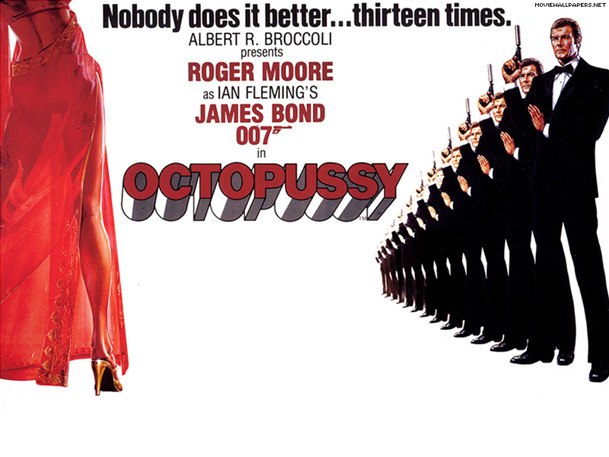Octopussy: A Sweet Distraction for an Hour or Two
by Adam Slusar (@TapwaterAlice)
Frequently lambasted for its cartoonish excesses, perplexing storyline and – of course – being the only James Bond film to see Roger Moore disguise himself as a clown, Octopussy is generally considered to be one of the weakest entries in the 007 franchise. Like Moonraker, the humor falls flat at times; look no further than one scene in which a Tarzan cry accompanies Bond as he swings across treetop vines. Ten years after his initial turn in Live and Let Die, Moore was ostensibly “too old” to play Bond any longer. And with the revered Sean Connery set to return as 007 in Never Say Never Again that same year, Octopussy was thrown into a “Battle of the Bonds.” The odds seemed stacked against it; film critics already knew which James Bond they preferred, and needless to say, it wasn’t Roger Moore.
But while Octopussy may falter due to its occasional missteps and oddities, it’s actually pretty great. A charming, elegant, and inventive action thriller, Octopussy is superior to Never Say Never Again in almost every way, and is by far the most unfairly maligned of the James Bond films.
While the previous effort, For Your Eyes Only, was a departure from the campier Bonds of the 1970’s, Octopussy retains a comfortable balance between fanciful escapism and Fleming-esque adventure. Richard Maibaum and Michael G. Wilson, in collaboration with George MacDonald Fraser, wrote a film that fits Roger Moore like a glove; combining his penchant for casual wit with his occasional ruthlessness (as evidenced by his car-kicking performance in For Your Eyes Only). We get to see Moore deal a few bullets in addition to his fair share of one-liners.
Even with age, Moore still proves perfectly capable of selling his unique brand of 007 in Octopussy, lending a sense of credibility without betraying the overall tone of the film. His performance acts as a nice counterpoint to his passive-aggressive portrayal in Moonraker. Although the vehemently detested “clown scene” is remembered for all the wrong reasons, it demonstrates Moore in an authentic, all-too-rare occurrence of Bond losing his cool as a doomsday machine counts down to its final seconds; much like The Spy Who Loved Me or For Your Eyes Only, this showcases Moore at his absolute finest.
In terms of progressive feminism and gender equality, Octopussy is a considerable milestone in a franchise made popular by its womanizing secret agent protagonist. Leading the charge – and an army of jumpsuit-wearing female acrobats – is Octopussy herself, a neutral entity working alongside the nefarious Kamal Khan (Louis Jourdan) in a grand-scale jewel smuggling plot. Previously seen as Andrea Anders in The Man with the Golden Gun, Maud Adams lends an air of mystery, assertiveness, and professionalism to role of Octopussy. Odd though it may be for a suggestively-named Bond girl to live on an island inhabited only by women while also running a travelling circus, these sort of extravagancies are part-and-parcel with the 007 franchise, and Octopussy exemplifies the standard of proactive female characters in the Bond films.
Octopussy marks the first (but not the last) Bond film to divide its screen-time between two main villains. In addition to Kamal Khan, we have General Orlov (Steven Berkhoff), the true mastermind behind the theft of a Fabergé egg and an evil plot to overtake Western Europe with a Russian artillery brigade. This is a brilliant plot perpetrated by two sub-standard villains, but Jourdan and Berkhoff do admirably with their otherwise thinly-written roles; Khan is given juicy dialogue to complement his incredibly suave demeanour, while Orlov chews up every scene with intense proclamations.
Filling in for Oddjob and Jaws this time around is the blunderbuss-wielding Gobinda, who gets to take on Bond in some of the most inspired stunt sequences in the film. In a nutshell, the villains of Octopussy leave something to be desired, but are still more colorful and entertaining than your average Blofeld regurgitation.
Clearly inspired by the high-adventure of Raiders of the Lost Ark two years prior, Octopussy contains no shortage of tremendous action scenes. This time around, we get to see Bond pilot a mini-jet while pursued by heat seeking missiles, taking on a thug with a razorblade yo-yo, leaping across train cars while evading dangerous obstacles, and even clinging for his life from the top of an airborne plane. Here, director John Glen demonstrates his strengths as an action director. He would continue to up the ante in his three subsequent efforts. Octopussy, nonetheless, contains some of the finest stunt choreography in the Bond series.
Following the post-disco instrumentals of Bill Conti in For Your Eyes Only (of which I’m admittedly a fan), John Barry returns to the Bond franchise with Octopussy, lending gravitas to the film with a sweeping, romantic score occasionally punctuated by frenetic action cues and exotic flair. His work in Octopussy would pave the way for his return in A View to a Kill and The Living Daylights, and Barry would provide those films with perhaps his greatest work.
If you aren’t a fan of the Roger Moore films leading up to it, then Octopussy may not be your cup of tea. Still, it isn’t the train-wreck that most people would have you believe. I first watched Octopussy late in the game, expecting something utterly terrible but coming away pleasantly surprised but also a little disturbed that so many people failed to see the pure joy of Bond escapism contained within. All the negativity surrounding Octopussy chalks up to needless comparisons to the Connery era and an unusual emphasis on the sillier aspects of the film. And truth be told, it is silly, but there’s just so much more to it.
First Bond Movie: Tomorrow Never Dies
Favorite Bond Actor: Roger Moore
Favorite Bond Girl: Solitaire
How I Discovered #Bond_age_: Nic Suszczyk of The GoldenEye Dossier, who invited me to participate in the Moonraker Live Tweet Session.


Trackbacks/Pingbacks